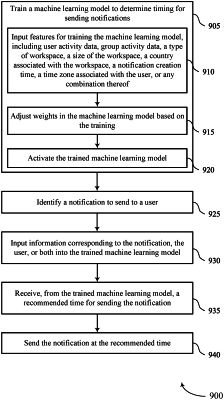| CPC H04L 51/224 (2022.05) [G06F 3/14 (2013.01); H04L 51/043 (2013.01)] | 16 Claims |

|
1. A method for determining notification timing in a group-based communication system, comprising:
identifying a notification to send to a user of the group-based communication system, the user associated with a user identifier and a workspace identifier in the group-based communication system;
retrieving one or more notification settings for the user;
tracking first active time data for the user corresponding to the user identifier based at least in part on an application supporting the group-based communication system being displayed via a user interface of a user device operated by the user and the user interacting with the application via the user interface within a threshold time window;
tracking second active time data for a plurality of users, additional to the user, corresponding to the workspace identifier;
determining, based on an output of a machine learning model and the one or more notification settings for the user, a time for sending the notification based at least in part on inputting, to the machine learning model, the first active time data for the user and inputting, to the machine learning model, the second active time data for the plurality of users;
automatically sending the notification for display via the user interface of the user device at the determined time;
collecting user engagement data associated with the user opening the notification, clicking the notification, or both based at least in part on the determined time for sending the notification; and
retraining the machine learning model based at least in part on the user engagement data and an optimization of an open rate for the notification, a click rate for the notification, or both to send notifications when a corresponding user is active.
|